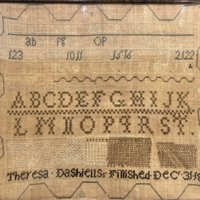Samplers are compilations of different elements, embroidered on a piece of fabric, often linen, that’s how the skills of the maker. The purpose of a sampler has likely changed over time, but we most often associate samplers from the 18th and 19th centuries as examples of embroidery or cross-stitching skills that the maker has practiced and refined – skills that were taught to young girls as part of their school lessons. The skills were taught so they could help with certain needs around the home but eventually became a status symbol – highlighting more challenging technique sand designs. These samplers often contain the alphabet, common phrases, and sometimes buildings, figures, or animals. If we are lucky, the sampler also includes a name and date that allows us to discover more about the person behind the work. This sampler was made by Theresa Dashiells and completed on Dec. 31, 1801.
Dublin Core
Title
Samplers are compilations of different elements, embroidered on a piece of fabric, often linen, that’s how the skills of the maker. The purpose of a sampler has likely changed over time, but we most often associate samplers from the 18th and 19th centuries as examples of embroidery or cross-stitching skills that the maker has practiced and refined – skills that were taught to young girls as part of their school lessons. The skills were taught so they could help with certain needs around the home but eventually became a status symbol – highlighting more challenging technique sand designs. These samplers often contain the alphabet, common phrases, and sometimes buildings, figures, or animals. If we are lucky, the sampler also includes a name and date that allows us to discover more about the person behind the work. This sampler was made by Theresa Dashiells and completed on Dec. 31, 1801.
Subject
Delmarva History
Description
Samplers are compilations of different elements, embroidered on a piece of fabric, often linen, that’s how the skills of the maker.
Source
Nabb Research Center
Date
1801
Rights
The use of this image may be subject to the copyright law of the United States (Title 17, United States Code) or to site license or other rights management terms and conditions. The person using the image is liable for any infringement.
Identifier
PHC688
Files
Collection
Citation
“Samplers are compilations of different elements, embroidered on a piece of fabric, often linen, that’s how the skills of the maker. The purpose of a sampler has likely changed over time, but we most often associate samplers from the 18th and 19th centuries as examples of embroidery or cross-stitching skills that the maker has practiced and refined – skills that were taught to young girls as part of their school lessons. The skills were taught so they could help with certain needs around the home but eventually became a status symbol – highlighting more challenging technique sand designs. These samplers often contain the alphabet, common phrases, and sometimes buildings, figures, or animals. If we are lucky, the sampler also includes a name and date that allows us to discover more about the person behind the work. This sampler was made by Theresa Dashiells and completed on Dec. 31, 1801.,” Nabb Research Center Online Exhibits, accessed January 11, 2026, https://libapps.salisbury.edu/nabb-online/items/show/514.
